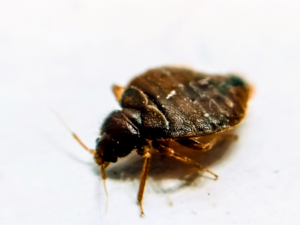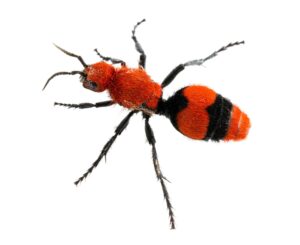Home / Blog / The Oriental Cockroach (aka Water Bug)
The Oriental Cockroach (aka Water Bug)

Scientifically reviewed by Daniel Baldwin, BCE, CCFS, CP-FS
-Published on August 12, 2022
-Updated on March 10, 2025
Cockroaches have existed on Earth for millions of years, and they’re able to adapt to nearly any type of climate. There are thousands of cockroach species living around the globe, but only four types are common in North America—including the oriental cockroach. Learn more about this type of roach, how it compares to a water bug, and how you can keep them out of your home.
What Are Oriental Cockroaches?
The oriental cockroach is larger than some other common roaches; they grow to be a little over 1 inch long, and are a member of the species Blatta orientalis. This insect is also often referred to as a water bug or a black beetle.What’s the Difference Between Water Bugs and Oriental Cockroaches?
The name “water bug” came to be used to refer to oriental cockroaches because they nest in areas that are dark and damp. They often travel through sewers and other types of pipes that handle water.
However, other insects are also called water bugs, and belong to the insect order known as Hemiptera. Hemiptera are insects that use their legs to paddle through the water and use the water’s surface tension to float. Giant water bugs can hold their breath underwater for very long periods, while Oriental cockroaches can float in water, but don’t swim.
These Giant water bugs also live near bodies of water but are an inch or two bigger than Oriental cockroaches. Cockroaches prefer living on the land in tight spaces.
While water bugs hunt and eat other insects that live in the water, cockroaches are scavengers that will eat anything they can find, including debris, animal and human waste, and garbage.
What Do Oriental Cockroaches Look Like?
The oriental cockroach (aka water bug) is black or very dark reddish-brown in color, with a bit of a greasy shininess to the body. It has six legs, which are spiked, and two antennae.The male cockroach is a little shorter than the female and has stubby wings, but it can’t fly. The females are a bit longer than the males and have no wings.
Because they have no sticky pads on their feet, oriental cockroaches can’t climb up smooth vertical surfaces, so you’re more likely to find them crawling across the floor or other rough surface when they’re disturbed or if you suddenly turn on a light. Although they appear quick, this species of cockroach is actually a much slower mover than others.
The oriental cockroach undergoes three stages of development, which are seasonal, with the adults appearing in late spring and dying off in early fall. The stages include:
- Egg: The eggs are laid in capsules, with each capsule containing about 16 eggs. They are laid near a food source and take about 60 days to hatch.
- Nymph: This stage lasts between 24–130 weeks.
- Adult: Adult oriental cockroaches live for up to 26 weeks and produce about 200 offspring.

Where Do Oriental Cockroaches Live?
Oriental cockroaches prefer living in dark, moist places where there is either water or high humidity. When nesting outdoors, they’re most often found beneath porches, in sewers, in unused cisterns, in bark mulch, and in garbage.
Inside the home, oriental cockroaches nest in damp basements and crawl spaces. They’ll enter your home if the outdoor temperature becomes too warm or dry, which is when they need to look for sources of water and food. Sometimes oriental cockroaches can come into your home via boxes or bags that you bring inside, as well as through garbage chutes or openings in utility pipes, vents, or air ducts. Some may even enter through your front door.
Although they tend to remain hidden and are nocturnal insects, you will eventually see oriental cockroaches if they’re in your home as they move around on pipes or show up in kitchens and bathrooms, where moisture and food can be found.
If you see just one water bug, it’s very likely that many more are hiding nearby. You might even detect an odd, unpleasant odor close to their nesting spot.
What Do Oriental Cockroaches Eat?
Oriental cockroaches can survive by eating practically anything edible they come into contact with, but they prefer starchy foods. They are known for consuming rotting food, raw sewage, and any type of organic matter that’s decaying.
They can also live for at least four weeks without eating any food at all. Without a water supply, though, this type of roach will die within two weeks.
What’s the Difference Between Water Bugs and Oriental Cockroaches?
A true water bug is called a giant water bug and is an aquatic insect that actually lives in water. Giant water bugs are about an inch or two bigger than Oriental cockroaches. Cockroaches prefer living on the land in tight spaces, but they need water to stay alive.Real water bugs are Hemiptera, insects that use their legs to paddle through the water and use the water’s surface tension to float. Giant water bugs can hold their breath underwater for very long periods. Oriental cockroaches can float in water, but they don’t swim.
While water bugs hunt and eat other insects that live in the water, cockroaches are scavengers that will eat anything they can find, including debris, animal and human waste, and garbage.

Does a Water Bug Look Like a Cockroach?
The exoskeleton of an Oriental cockroach is small and has a glossy sheen with black or dark brown coloring, while a true giant water bug is two to four inches long and has a grayish-brown color resembling a dead leaf. A giant water bug found inside the home is rare and not a cause for concern. However, its counterpart, the oriental cockroach (aka also the water bug), is because usually, when there is one, there are many more.
Are Oriental Cockroaches Dangerous?
Because the Oriental cockroach can transmit diseases, they are dangerous to the health of humans. These insects are capable of spreading bacteria that they pick up on their legs to many areas of the home as they move about.
Water bugs move around a home looking for crumbs, spills, and unsealed food. Countertops, cooking utensils, bathroom items, and other household items can all become contaminated with bacteria if water bugs crawl around on them.
The oriental cockroach can transmit illnesses, such as salmonella, dysentery, or E. coli. They can also cause asthma attacks and allergic reactions in some people.
How Can You Prevent Oriental Cockroaches From Coming Into the House?
To help prevent water bugs from getting inside, seal all possible points of entry, like cracks and crevices in walls, siding, doors, vents, and windows, tightly with either caulk or steel wool. Keep moisture buildup to a minimum by using a dehumidifier in basements and other damp areas and close up any spaces around outdoor utility pipes and water lines.
Eliminate any standing or leaking water sources that will attract water bugs to your home, especially near the foundation. Check that gutters and downspouts are working correctly to move water away from the home.
Clear away woodpiles, leaves, and other debris near windows and doors. Inside the home, clean up crumbs, wipe kitchen counters, vacuum floors daily, and wash all dishes in the sink.
What Attracts Oriental Cockroaches?
Water bugs are attracted to moist, humid environments where food and water are available. Water is necessary for these insects, which is why they’re drawn to warm, damp spaces, like basements, bathrooms, kitchens, garages, and attics, and any place with drains and pipes to travel through.
What Smell Keeps Oriental Cockroaches Away?
Some essential oils, such as peppermint, oregano, cypress, cedarwood, and catnip, can repel some cockroach species. Cockroaches have also been known to move away from the smell of crushed bay leaves and coffee grounds. While some of these smells may deter a few water bugs, only a professional pest control service can truly help if you have an infestation.
What Causes Oriental Cockroaches to Nest in a Home?
Homes have most of what water bugs need to survive, including hiding spots, food, water, and warmth. They tend to enter homes during hot, dry weather and nest where they can find provisions.
How To Get Rid of Oriental Cockroaches
When attempting to get rid of oriental cockroaches, you first need to find out how they entered your home. Inspect your house for points of entry, including cracks that lead to the basement, gaps in the siding, spaces where pipes enter your home, and holes in the ground around your house’s perimeter.
Because oriental cockroaches hide in deep, dark holes that are hard for us to reach, it’s best to use sticky traps to trap them in places you suspect they’re nesting.
Cockroaches of all kinds can be difficult to get out once they’ve infested a home. If you are having trouble with an oriental cockroach/water bug infestation, it may be best to contact a pest control company for assistance. Pest control professionals will treat the areas where these insects may be entering your home, targeting the foundation and other points of entry. Your yard, lawn, and garden will also be inspected for signs of these critters around your property.
Related Articles
Visit our blog to learn more.
→





